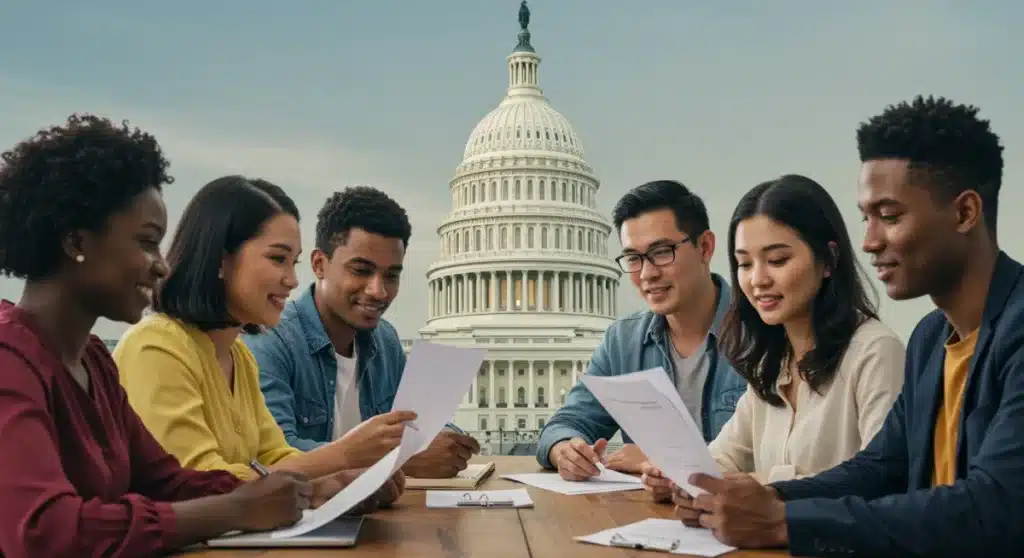Federal Student Loan Forgiveness Programs 2025: What US Borrowers Need to Know

Understanding federal student loan forgiveness programs in 2025 is essential for US borrowers seeking debt relief, requiring careful navigation of evolving eligibility criteria and application processes.
Navigating Federal Student Loan Forgiveness Programs in 2025: What Borrowers in the US Need to Know Now is a critical topic for millions across the nation. With continuous changes in policy and an evolving economic landscape, staying informed is paramount to unlocking potential debt relief. This comprehensive guide aims to demystify these programs, providing clarity on what you can expect and how to prepare.
Understanding the Current Landscape of Federal Loan Forgiveness
The terrain of federal student loan forgiveness is dynamic, influenced by legislative changes, economic shifts, and administrative priorities. As we look towards 2025, borrowers must grasp the foundational programs still in effect, as well as anticipated adjustments. These programs are designed to alleviate the burden of student debt for those who meet specific criteria, often linked to public service, income, or certain life events.
Several key programs form the backbone of federal student loan forgiveness. Public Service Loan Forgiveness (PSLF), Income-Driven Repayment (IDR) plans, and specific discharge options for disability or school closure are among the most prominent. Each program carries its own set of rules, eligibility requirements, and application procedures, making a one-size-fits-all approach impossible. Borrowers need to identify which program, if any, aligns with their unique financial situation and career path. The federal government continues to refine these programs, often in response to borrower feedback and economic data, so staying updated is not just advisable, but necessary.
Key Federal Forgiveness Programs
- Public Service Loan Forgiveness (PSLF): Designed for individuals working for eligible government or non-profit organizations.
- Income-Driven Repayment (IDR) Plans: Offer forgiveness of remaining loan balances after 20 or 25 years of qualifying payments.
- Teacher Loan Forgiveness: Provides relief for educators in low-income schools or educational service agencies.
It’s important to remember that qualifying for these programs often involves meticulous record-keeping and consistent adherence to program rules. Understanding the nuances of each program is the first step toward successfully securing forgiveness. The federal government’s commitment to these programs underscores a broader effort to support borrowers and ensure that educational debt does not become an insurmountable barrier.
Public Service Loan Forgiveness (PSLF) in 2025: What’s New?
Public Service Loan Forgiveness (PSLF) has been a beacon of hope for many dedicated public servants, and 2025 promises continued evolution in its implementation. This program offers forgiveness of the remaining balance on Direct Loans after 120 qualifying monthly payments have been made under a qualifying repayment plan while working full-time for an eligible employer. The concept is straightforward, but the execution has historically presented challenges for borrowers.
Recent years have seen significant efforts to streamline and improve the PSLF program, including temporary waivers that allowed more payments and loan types to qualify. While these waivers may not be permanent, their impact highlights the government’s recognition of the program’s importance and the need for greater accessibility. Borrowers should anticipate a continued focus on transparency and borrower support, though the core requirements of eligible employment and qualifying payments are likely to remain.
Eligibility Requirements for PSLF
- Eligible Employment: Full-time employment with a U.S. federal, state, local, or tribal government organization, or a non-profit organization.
- Loan Types: Only Direct Loans are eligible. Other federal loans may become eligible after consolidation into a Direct Consolidation Loan.
- Qualifying Payments: 120 payments made under a qualifying repayment plan, such as an Income-Driven Repayment (IDR) plan.
Staying diligent with employment certification forms annually and keeping thorough records of payments are crucial steps for PSLF hopefuls. The Department of Education often provides updates and resources to help borrowers navigate the process, and utilizing these tools can make a significant difference in a successful application. The commitment to public service is often a lifetime endeavor, and PSLF aims to alleviate financial stress for those who choose this path.
Income-Driven Repayment (IDR) Plans and Forgiveness
Income-Driven Repayment (IDR) plans are designed to make federal student loan payments more manageable by capping them at a percentage of your discretionary income. Beyond affordable monthly payments, a significant benefit of IDR plans is the promise of loan forgiveness after a certain period, typically 20 or 25 years, depending on the plan and whether you have graduate or undergraduate loans. In 2025, these plans will continue to be a cornerstone of federal student loan relief, with ongoing efforts to refine and improve their accessibility and effectiveness.
The administration has focused on addressing historical issues with IDR plans, including payment miscalculations and difficulties in tracking qualifying payments. Borrowers can expect continued enhancements to ensure that progress towards forgiveness is accurately tracked and communicated. Understanding the various IDR options—such as REPAYE, PAYE, IBR, and ICR—is vital, as each has slightly different terms regarding payment caps and forgiveness timelines. Choosing the right plan can significantly impact your financial future and your journey towards loan forgiveness.
Types of IDR Plans
- REPAYE (Revised Pay As You Earn): Generally offers the lowest payments, capped at 10% of discretionary income.
- PAYE (Pay As You Earn): Payments are 10% of discretionary income, but never more than the 10-year Standard Repayment Plan amount.
- IBR (Income-Based Repayment): Payments are generally 10% or 15% of discretionary income, depending on when you took out your loans.
- ICR (Income-Contingent Repayment): Payments are either 20% of discretionary income or what you’d pay on a fixed 12-year plan, whichever is less.
Regularly recertifying your income and family size is a mandatory step for all IDR participants to ensure your payments remain accurate and you continue to qualify for the plan. The goal of IDR forgiveness is to provide a safety net, ensuring that borrowers are not burdened by student debt indefinitely, especially if their income remains modest relative to their loan balance. The ongoing review of IDR plans aims to make this safety net more robust and reliable for all eligible borrowers.
Teacher Loan Forgiveness and Other Specific Programs
Beyond the broader forgiveness initiatives, several targeted programs exist to support specific professions or circumstances. Teacher Loan Forgiveness is one such program, recognizing the invaluable contribution of educators. This program can forgive up to $17,500 of Direct Subsidized and Unsubsidized Loans, or Stafford Loans, for eligible teachers who work full-time for five consecutive years in low-income schools or educational service agencies. The specific amount of forgiveness depends on the subject taught.
Other specialized programs include total and permanent disability discharge, which provides relief for borrowers who can no longer work due to a medical condition. Furthermore, borrowers whose schools closed while they were enrolled or shortly after withdrawing may be eligible for a closed school discharge. These programs, while not as widely applicable as PSLF or IDR, provide crucial relief for those facing unique challenges. Understanding these niche options is essential for borrowers who may qualify, as they offer significant financial alleviation.

The government’s commitment to these specialized programs reflects an understanding that student debt relief needs to be multifaceted, addressing a variety of situations. Each program has distinct criteria and application processes, emphasizing the need for thorough research and, often, professional guidance. For instance, the Teacher Loan Forgiveness program requires specific certifications from school administrators, while disability discharge involves documentation from medical professionals.
Additional Forgiveness and Discharge Options
- Total and Permanent Disability (TPD) Discharge: Forgiveness for borrowers unable to engage in substantial gainful activity due to a medical condition.
- Closed School Discharge: Forgiveness for students whose school closed while they were attending or soon after they withdrew.
- Borrower Defense to Repayment: Forgiveness for borrowers who were defrauded by their school.
These programs, while specific, are vital components of the overall federal student loan relief landscape. They provide targeted support where it is most needed, ensuring that borrowers facing particular hardships or serving in critical roles have avenues for debt relief. Staying informed about the eligibility requirements and application procedures for each is paramount.
Preparing for Changes and New Initiatives in 2025
The federal student loan landscape is rarely static, and 2025 will likely bring its own set of changes and new initiatives. Borrowers should anticipate potential legislative reforms, administrative adjustments, and possibly new programs designed to address persistent student debt challenges. A proactive approach to staying informed is the best defense against being caught off guard by policy shifts. This involves regularly checking official government sources, such as the Department of Education’s website, and subscribing to reputable financial aid news outlets.
One area to watch closely is the ongoing discussion around simplifying the application processes for existing programs and improving borrower communication. Past challenges have highlighted the need for clearer guidance and more streamlined procedures. Any new initiatives are likely to focus on making forgiveness more accessible and understandable for the average borrower. Furthermore, economic indicators and the broader political climate could influence the scope and availability of future relief efforts.
Tips for Staying Informed
- Monitor Official Sources: Regularly check the U.S. Department of Education and Federal Student Aid websites.
- Engage with Loan Servicers: Keep your contact information updated with your loan servicer and inquire about relevant program changes.
- Consult Financial Aid Professionals: Seek advice from certified financial counselors or non-profit organizations specializing in student debt.
Preparing for these changes also means maintaining accurate records of your loan payments, employment history, and any communications with your loan servicer. This documentation will be invaluable should you need to apply for forgiveness or appeal a decision. Being prepared and proactive will ensure that you are well-positioned to take advantage of any opportunities for relief that arise in 2025 and beyond.
Strategies for Maximizing Your Forgiveness Potential
Successfully navigating federal student loan forgiveness programs requires more than just understanding the rules; it demands a strategic approach tailored to your individual circumstances. Maximizing your forgiveness potential involves a combination of diligent record-keeping, consistent communication, and proactive planning. One of the most critical strategies is to ensure you are enrolled in the correct repayment plan for your goals.
For those pursuing PSLF, this means being in an Income-Driven Repayment (IDR) plan and submitting your Employment Certification Form (ECF) annually, or whenever you change employers. For IDR forgiveness, it’s about consistently recertifying your income and family size each year to ensure your payments are accurately calculated and you’re making steady progress toward the forgiveness timeline. Don’t underestimate the power of regular check-ins with your loan servicer to confirm your payment count and address any discrepancies early.
Key Strategies for Borrowers
- Choose the Right Repayment Plan: Align your repayment strategy with your forgiveness goal (e.g., IDR for PSLF or IDR forgiveness).
- Keep Meticulous Records: Document all payments, employment, and communications with your loan servicer.
- Annual Recertification: For IDR plans, ensure timely annual recertification of income and family size.
- Consolidate When Necessary: Consider Direct Loan Consolidation if you have older federal loans that don’t qualify for certain programs.
Another often-overlooked strategy is to understand the tax implications of forgiveness. While PSLF and disability discharges are generally tax-free, IDR forgiveness may be subject to federal income tax on the forgiven amount, though this has also been subject to temporary waivers. Consulting a tax professional can help you plan for any potential tax liability. By taking these strategic steps, borrowers can significantly increase their chances of successfully achieving federal student loan forgiveness.
Common Pitfalls and How to Avoid Them
While federal student loan forgiveness programs offer significant relief, many borrowers encounter common pitfalls that can delay or even derail their eligibility. Understanding these obstacles beforehand is key to a smoother path toward forgiveness. One of the most frequent issues is incorrect loan types. Only Direct Loans are eligible for PSLF, and while other federal loans can be consolidated, this step must be taken correctly and timely.
Another common pitfall is inconsistent qualifying payments. Borrowers must ensure they are on an eligible repayment plan and that their payments are made on time and for the full amount. Missing payments, making partial payments, or being in the wrong repayment plan can reset or delay your progress toward forgiveness. Furthermore, a lack of proper documentation, especially for employment certification or income recertification, can lead to significant delays and denials. The burden of proof often falls on the borrower, making meticulous record-keeping essential.
Mistakes to Avoid
- Incorrect Loan Types: Ensure your loans are Direct Loans or have been consolidated into one.
- Wrong Repayment Plan: Be on a qualifying repayment plan (e.g., IDR for PSLF).
- Inconsistent Payments: Make 120 on-time, full payments under a qualifying plan.
- Lack of Documentation: Keep thorough records of employment, payments, and communications.
- Ignoring Annual Recertification: For IDR plans, failing to recertify income can lead to increased payments or loss of progress.
Many borrowers also fall into the trap of not actively engaging with their loan servicer. It’s crucial to communicate any changes in employment, income, or contact information and to regularly check your payment count and eligibility status. Proactively addressing any discrepancies or questions can prevent future headaches. By being aware of these common pitfalls and taking steps to avoid them, borrowers can navigate the complexities of federal student loan forgiveness with greater confidence and success.
| Key Program | Brief Description |
|---|---|
| PSLF | Forgiveness for public servants after 120 qualifying payments. |
| IDR Forgiveness | Remaining balance forgiven after 20-25 years of income-driven payments. |
| Teacher Loan Forgiveness | Up to $17,500 for eligible teachers in low-income schools. |
| Disability Discharge | Total forgiveness for borrowers with a permanent disability. |
Frequently Asked Questions About Federal Loan Forgiveness
PSLF forgives loans after 10 years of payments for public service employment, while IDR forgiveness occurs after 20 or 25 years of payments, regardless of employment type, though often with a taxable amount.
Not all. Only Direct Loans are directly eligible for most programs. FFEL Program loans and Perkins Loans usually need to be consolidated into a Direct Consolidation Loan to become eligible for PSLF or IDR plans.
For PSLF, you should submit an Employment Certification Form annually. For IDR plans, you must recertify your income and family size annually to keep your payments accurate and progress towards forgiveness.
If your loan servicer changes, your loans and payment history will be transferred. It’s crucial to confirm the transfer, update your contact information, and ensure all records are accurate with the new servicer.
PSLF and Total and Permanent Disability discharges are generally not taxable. However, forgiveness under Income-Driven Repayment plans can be considered taxable income by the IRS, though this has seen temporary waivers.
Conclusion
Navigating Federal Student Loan Forgiveness Programs in 2025: What Borrowers in the US Need to Know Now is a continuous journey that requires vigilance and proactive engagement. The federal government offers various avenues for debt relief, each with its own specific requirements and benefits. By understanding the nuances of programs like PSLF, IDR, and specialized discharges, and by diligently managing your loans and documentation, you can significantly enhance your chances of achieving forgiveness. Stay informed, stay organized, and don’t hesitate to seek expert advice to make the most of the opportunities available to you.





